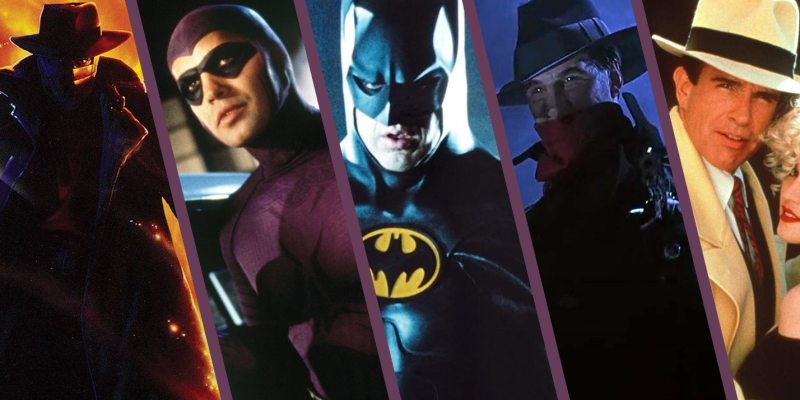Next month, Sam Raimi will make his mark on the Marvel Cinematic Universe with Doctor Strange in the Multiverse of Madness. It feels like something of a homecoming for the director, who is often credited with kickstarting the modern superhero movie boom with his Spider-Man trilogy, along with Stephen Norrington’s Blade or Bryan Singer’s X-Men. What is interesting about Raimi’s return to the genre is that it effectively marks the third wave of Raimi’s involvement with the genre’s evolution.
In 1990, Sam Raimi directed Darkman. The film was a modest success, earning $48M on a $16M budget. Although Darkman has accumulated a cult following (and two direct-to-video sequels), it belongs to a larger movement in superhero cinema that is often overlooked. There was a modest outcropping of superhero- and comic book-inspired movies in the first half of the 1990s, something of a blip before the earth-shattering boom.
These movies reflect a very distinct sensibility, particularly when compared to modern comic book movies. By and large, with rare exceptions like the R-rated Darkman or the controversial Batman Returns, these are broad family crowd-pleasers. They are also firmly rooted in a classical tradition, steeped in a nostalgic aesthetic. Befitting their early place in the development of the superhero movie, they feel particularly rooted in the classic era known as the Golden Age of Comics.
Tim Burton’s Batman is often rightly singled out as the epicenter of this movement. After all, the 1989 superhero adventure was a genuine cultural phenomenon. It redefined what a blockbuster could be. Batman premiered in a summer dominated by franchise films, like Lethal Weapon 2, License to Kill, Back to the Future Part II, The Karate Kid Part III, and Ghostbusters II. What allowed Burton’s Batman to stand out, and to dominate the domestic box office, was its distinct texture.

Burton’s Batman took place in something close to the modern day, with color television sets and contemporary urban decay, but it had the feel of something much older. The film features an early scene at a tuxedo gala at Wayne Manor. Jack Napier (Jack Nicholson) is an old-fashioned Hollywood gangster, who is transformed at the “Axis” Chemical Plant and who evokes James Cagney from the 1949 film noir White Heat.
Of course, nothing emerges from a vacuum. The style of Batman was perhaps the culmination of a number of trends building through the late 1980s. The combination of a harsh film noir aesthetic with a more colorful and cartoonish sensibility arguably reached its apex a year earlier in Robert Zemeckis’ Who Framed Roger Rabbit? The sort of gangsters played by Jack Palance and Jack Nicholson in Batman would have felt at home in Brian De Palma’s The Untouchables, two years prior.
The year after Burton’s Batman, Warren Beatty accomplished something similar with Dick Tracy. Shot by Academy Award-winning cinematographer Vittorio Storaro, who had worked with Francis Ford Coppola on Apocalypse Now and with Beatty on Reds, Dick Tracy looked like a comic strip brought to life. It was lit and designed in strong and vibrant colors, with makeup transforming Hollywood icons into breathing caricatures.
None of the movies that followed would go quite as far as Batman or Dick Tracy, but they codified a template for a wave of superhero and comic book adaptations. Sam Raimi’s Darkman released close enough to those two films that its similarities were likely coincidental, but one can see the influence of Batman and Dick Tracy on projects like Joe Johnston’s The Rocketeer, Russell Mulcahy’s The Shadow, Chuck Russell’s The Mask, and Simon Wincer’s The Phantom.

These films were linked by common traits. They all felt decidedly retro and old-fashioned. Dick Tracy, The Rocketeer, The Shadow, and The Phantom were all explicitly period pieces set in the 1930s and 1940s. While Darkman and The Mask were clearly set in the modern day with elements like computers and phones, they tended to feature markers associated with the cultural memory of that earlier era: swing music, trench coats, carnies, Tommy guns.
Old-fashioned gangsters featured prominently: Big Boy Caprice (Al Pacino) in Dick Tracy, Robert G. Durant (Larry Drake) in Darkman, Eddie Valentine (Paul Sorvino) in The Rocketeer, Dorian Tyrell (Peter Greene) in The Mask, Charlie Zephro (David Proval) in The Phantom. These gangsters mingled with seemingly legitimate businessmen like Louis Strack Jr. (Colin Friels) in Darkman or Xander Drax (Treat Williams) in The Phantom.
There were other throwback elements, such as a tendency on the classic archetype of the female reporter. In Darkman, Peyton Westlake (Liam Neeson) is dating attorney Julie Hastings (Frances McDormand), who uncovers a property development scandal in the style of an investigative journalist. In The Phantom, Diana Palmer (Kristy Swanson) becomes embroiled in the adventure when her uncle’s newspaper reveals Drax’s sinister schemes. In The Mask, agony-aunt-turned-investigative-reporter Peggy Brandt (Amy Yasbeck) is a red herring love interest.
Reflecting the brutality of 1930s and 1940s comic strip heroes, these films were morally ambiguous. In Darkman, as with later films like The Crow or Spawn, Peyton is motivated primarily by sadistic revenge on the people who deformed him. In The Mask, Stanley Ipkiss (Jim Carrey) uses his powers to punish those who wronged him. In The Shadow, Lamont Cranston (Alec Baldwin) mind-controls anyone who crosses his path and conscripts people he rescues into his private army.

These 1990s heroes are surprisingly violent. Dick Tracy (Warren Beatty) knows his way around the business end of a machine gun. The eponymous heroes of both The Shadow and The Phantom dual-wield pistols, and an early sequence in The Shadow features Cranston using his sidearms to shoot a concrete block off the feet of Roy Tam (Sab Shimono). Even Michael Keaton’s Batman is decidedly more kill-happy than most iterations of the character.
There is enough shared DNA between these movies that they feel like a distinct subgenre unto themselves, one different from the modern wave of superhero movies. Obviously, these weren’t the first superhero movies – or even the first modern superhero movies – but they were the first to emerge after the end of the Christopher Reeves Superman franchise. It’s interesting that they feel so tethered to the era from which the superhero originally emerged, the 1930s and the 1940s.
This was perhaps a reflection of larger cultural trends. In the early 1990s, superhero comics were themselves reconnecting with their roots. In 1993, James Robinson and Paul Smith would publish The Golden Age at DC, looking back on the classic heroes of the 1930s and 1940s. Robinson would then work with artist Tony Harris on Starman, a beloved long-running series about the son of the eponymous Golden Age hero. Robinson would also launch a Justice Society of America book in 1999.
It’s notable, for example, that this wave of retro superhero movies overlapped neatly with the swing revival of the era, which can trace its roots back to Los Angeles in 1989. It’s possible to draw a clear line between fedoras and suits that populate these movies and the movement that would build to a crescendo with “the Summer of Swing” in 1998. The Mask even makes the connection explicit, with a lot of the action unfolding at a swanky nightclub that seems to exclusively play swing music.

It might also be tied to the fact that these movies came out as America was approaching the 50th anniversary of the Second World War. A few years after headlining Darkman, Liam Neeson would star in Schindler’s List. The 1990s was the decade of movies like The Thin Red Line, Saving Private Ryan, Life Is Beautiful, and even Jakob the Liar. Was it any surprise that The Rocketeer would find its hero fighting Nazis on home terrain?
Indeed, these films followed the end of the Cold War, which may explain why they so effectively mirror the film noir movies that emerged in the wake of the Second World War. By and large, the villains of these movies are gangster capitalists. Legitimate and criminal enterprises often intermingle. Billionaire Louis Strack is the real villain of Darkman, not gangster Robert Durant. Big Boy Caprice dreams of taking the mob into legitimate business in Dick Tracy.
That said, perhaps this trend simply tapped into the nostalgia of the people making these movies. These were blockbusters heavily influenced by the New Hollywood movement of the 1970s, itself rooted in a nostalgia for the 1930s evident in films like Bonnie and Clyde, The Godfather, and Chinatown. Is it a surprise that when Warren Beatty hired Al Pacino, James Caan, and Dustin Hoffman to make a comic book movie, the result looked like a cartoon version of a 1930s gangster film?

Indeed, one suspects that these films took many of their cues from a success outside the genre: Steven Spielberg’s Indiana Jones trilogy. Tom Breihan has argued that The Rocketeer is “a whole lot closer to Indiana Jones And The Last Crusade, another 1989 blockbuster, than it is to Batman.” The Phantom was written by Last Crusade screenwriter Jeffrey Boam, and the influence is obvious. Malcolm Johnson quipped that the movie “might be subtitled ‘Raiders of the Lost Skulls.’”
Whatever the reason for this throwback aesthetic, these movies share a distinct texture and feeling. It’s fascinating to revisit these films in a modern blockbuster age dominated by verisimilitudinous green screen and computer-generated effects. The Mask serves as something of a threshold point here, with its pioneering use of digital effects. With the use of old-fashioned techniques like matte paintings, forced perspective, and set design, there’s an endearing timelessness to these films.
Sam Raimi’s career has lasted long enough that he has checked in on the superhero movie at three very different points in its evolution. Doctor Strange in the Multiverse of Madness is an important film for the Marvel Cinematic Universe. Spider-Man helped shape how audiences understand the genre. However, Darkman was part of an earlier and often unfairly forgotten moment in the movement’s evolution, synthesizing Golden Age Hollywood and Golden Age Comics.
